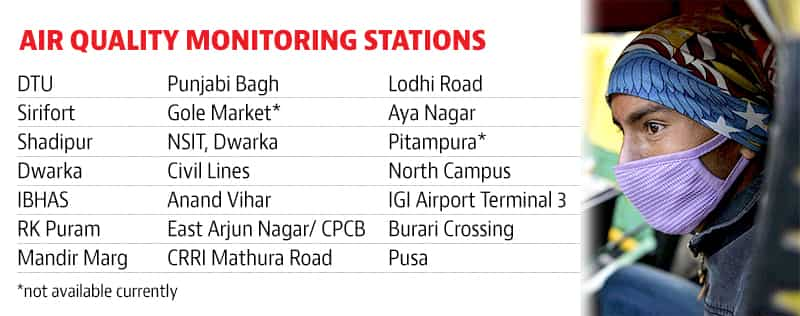Where can you check your air quality this Diwali?
It is now possible for people in some of Delhi’s neighbourhoods to track air quality real time in their area online or through mobile apps.
With all the explosive news about Delhi’s air pollution it can be hard for the public to figure what the air quality really is in their neighbourhood at a particular time on a particular day.
Air quality surveillance is poor in India but there is more information available online now than ever before. A lot of it is real time monitoring for several pollutants.
In Delhi particulate matter (PM 10 and PM 2.5) is the major cause for poor air quality, but there are other pollutants too like sulphur and nitrogen oxides, ozone, carbon monoxide, that often breach permissible limits.
The most useful air quality information for the public is where data has been converted to easy-to-understand indices. These indices, take into account levels of different pollutants, and spit out one figure that captures the overall air quality.
The index values are classified into categories depending on the impact of that level of pollution on human health, so that people can take appropriate steps to protect themselves.
Here is a guide to the most reliable sources of air pollution data for Delhi.
USP: Users can submit complaints about vehicular pollution, industrial emissions, open burning, construction/demolition activities.
Since CPCB is the primary agency responsible for tracking air pollution it has the most widespread network. There are over 680 stations all over the country.
The CPCB shares absolute values of pollutant levels and the Air Quality Index (AQI) values. The AQI is calculated based on the measurement of 8 pollutants. Using these index values the air quality can fall into 6 categories: Good, Satisfactory, Moderately polluted, Poor, Very Poor, and Severe.
This information is on its site and easily accessible on the SAMEER app which is updated hourly.



The U.S. Embassy’s air pollution monitor only covers the area of Chanakyapuri, where the embassy is located.
USP: Puts ground level data in international perspective. The US embassy has a different way of calculating its index and different categories for air quality.
Aggregators
World Air Quality Index project
The World Air Quality Index project is a non-profit initiative launched in 2007 and based in Beijing. It aggregates air quality information from cities across the world, including Delhi.
Hindustan Times has an in-house air quality monitoring site. It uses data from the CPCB and American embassies to present air quality situation in 33 cities including the capital.
National AQI: Associated Health Impacts
Good: (0–50): Minimal Impact
Satisfactory (51–100): May cause minor breathing discomfort to sensitive people.
Moderately polluted (101–200): May cause breathing discomfort to people with lung disease such as asthma, and discomfort to people with heart disease, children and older adults.
Poor (201–300): May cause breathing discomfort to people on prolonged exposure, and discomfort to people with heart disease
Very Poor (301–400): May cause respiratory illness to the people on prolonged exposure. Effect may be more pronounced in people with lung and heart diseases.
Severe (401-500): May cause respiratory impact even on healthy people, and serious health impacts on people with lung/heart disease. The health impacts may be experienced even during light physical activity.
(Source: CPCB)





